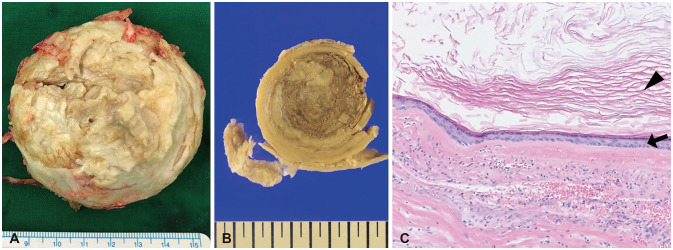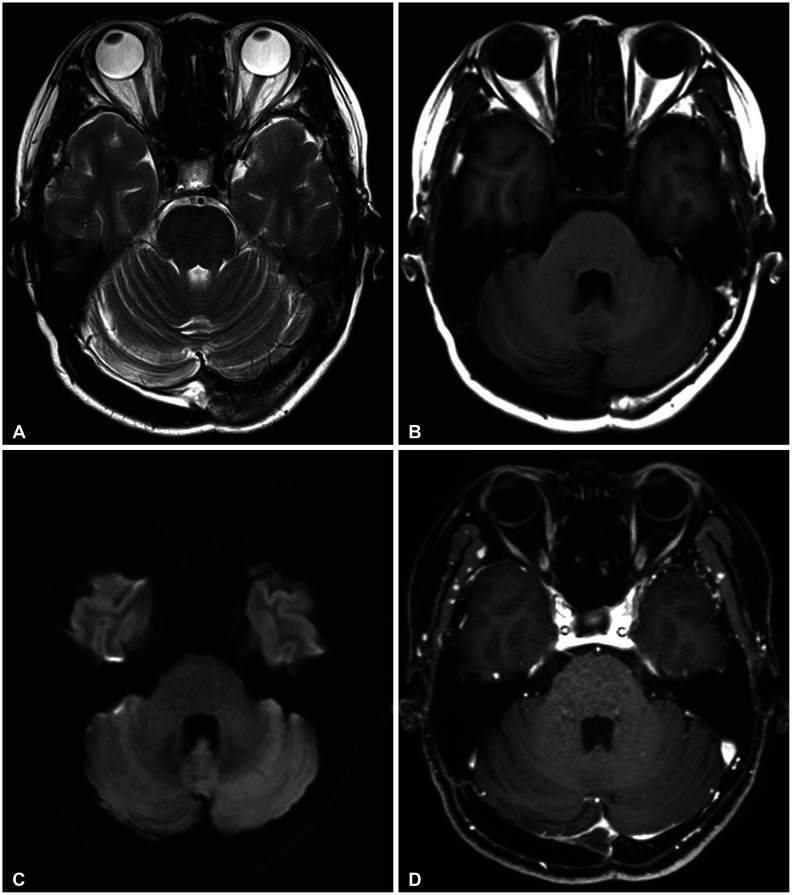1. Rubin G, Scienza R, Pasqualin A, Rosta L, Da Pian R. Craniocerebral epidermoids and dermoids. A review of 44 cases. Acta Neurochir (Wien). 1989; 97:1–16. PMID:
2718791.
2. Tan TI. Epidermoids and dermoids of the central nervous system. (With two exceptional cases not represented in the literature). Acta Neurochir (Wien). 1972; 26:13–24. PMID:
5043165.
3. Ciappetta P, Artico M, Salvati M, Raco A, Gagliardi FM. Intradiploic epidermoid cysts of the skull: report of 10 cases and review of the literature. Acta Neurochir (Wien). 1990; 102:33–37. PMID:
2407051.
4. Prall JA, Lloyd GL, Breeze RE. Traumatic brain injury associated with an intradiploic epidermoid cyst: case report. Neurosurgery. 1995; 37:523–525. PMID:
7501121.
5. Ulrich J. Intracranial epidermoids. A study on their distribution and spread. J Neurosurg. 1964; 21:1051–1058. PMID:
14279825.
6. Singh N, Symons SP, Montanera W, et al. Hemorrhagic epidermoid cyst in a patient with generalized tonic clonic seizure. J Clin Neurosci. 2013; 20:750–752. PMID:
23352350.
7. Kveton JF, Glasscock ME 3rd, Christiansen SG. Malignant degeneration of an epidermoid of the temporal bone. Otolaryngol Head Neck Surg. 1986; 94:633–636. PMID:
3088529.
8. Dupre DA, Pu C, Yu A, Tomycz N. Traumatic intradiploic epidermoid cyst manifest as scalp papule. BMJ Case Rep. 2015; 2015:bcr2014207968.
9. Constans JP, Meder JF, De Divitiis E, Donzelli R, Maiuri F. Giant intradiploic epidermoid cysts of the skull. Report of two cases. J Neurosurg. 1985; 62:445–448. PMID:
3973714.
10. Krupp W, Heckert A, Holland H, Meixensberger J, Fritzsch D. Giant intradiploic epidermoid cyst with large osteolytic lesions of the skull: a case report. J Med Case Rep. 2012; 6:85. PMID:
22439665.
11. Hasturk AE, Basmaci M, Yilmaz ER, Kertmen H, Gurer B, Atilgan AO. Giant intradiploic epidermoid cyst presenting as solitary skull mass with intracranial extension. J Craniofac Surg. 2013; 24:2169–2171. PMID:
24220431.
12. Jaiswal AK, Mahapatra AK. Giant intradiploic epidermoid cysts of the skull. A report of eight cases. Br J Neurosurg. 2000; 14:225–228. PMID:
10912199.
13. Bhaskar MS, Char G, Bhatt RP. Giant cranial intradiploic epidermoid cyst. West Indian Med J. 1988; 37:119–122. PMID:
3218226.
14. Maiuri F, Del Basso De Caro M, D'Acunzi G, Tortora F, Esposito F. Giant intradiploic epidermoid cyst of the occipital bone. Zentralbl Neurochir. 2004; 65:32–35. PMID:
14981574.
15. Duan ZX, Chu SH, Ma YB, Zhang H, Zhu JL. Giant intradiploic epidermoid cyst of the occipital bone. J Clin Neurosci. 2009; 16:1478–1480. PMID:
19586771.
16. Oommen A, Govindan J, Peroor DS, Azeez CR, Rashmi R, Abdul Jalal MJ. Giant occipital intradiploic epidermoid cyst. Asian J Neurosurg. 2018; 13:514–517. PMID:
29682075.
17. Arko L 4th, Berry CT, Desai AS, Weaver M. Intradiploic epidermoid tumors of the cranium: case report with review of the literature. J Neurol Surg A Cent Eur Neurosurg. 2017; 78:167–179. PMID:
27556641.
18. Smirniotopoulos JG, Chiechi MV. Teratomas, dermoids, and epidermoids of the head and neck. Radiographics. 1995; 15:1437–1455. PMID:
8577967.
19. Bikmaz K, Cosar M, Bek S, Gokduman CA, Arslan M, Iplikcioglu AC. Intradiploic epidermoid cysts of the skull: a report of four cases. Clin Neurol Neurosurg. 2005; 107:262–267. PMID:
15884157.
20. Dunn RC Jr, Archer CA, Rapport RL 2nd, Looi LM. Unusual CT-dense posterior fossa epidermoid cyst: case report. J Neurosurg. 1981; 55:654–656. PMID:
7277016.
21. Hasegawa H, Bitoh S, Nakata M, Fujiwara M, Yasuda H. Intracranial epidermoid mimicking meningioma. Surg Neurol. 1981; 15:372–374. PMID:
9760977.
22. Timmer FA, Sluzewski M, Treskes M, van Rooij WJ, Teepen JL, Wijnalda D. Chemical analysis of an epidermoid cyst with unusual CT and MR characteristics. AJNR Am J Neuroradiol. 1998; 19:1111–1112. PMID:
9672020.
23. Inoue Y, Ohata K, Nakayama K, Haba T, Shakudo M. An unusual middle fossa interdural epidermoid tumor. Case report. J Neurosurg. 2001; 95:902–904. PMID:
11702885.
24. Arana E, Martí-Bonmatí L. CT and MR imaging of focal calvarial lesions. AJR Am J Roentgenol. 1999; 172:1683–1688. PMID:
10350315.
25. Hakyemez B, Aksoy U, Yildiz H, Ergin N. Intracranial epidermoid cysts: diffusion-weighted, FLAIR and conventional MR findings. Eur J Radiol. 2005; 54:214–220. PMID:
15837401.
26. Juglard R, Elfikri A, Fesselet J, et al. Intradiploic epidermoid cyst: diagnosis by ultrasonography and MRI. J Radiol. 2003; 84(2 Pt 1):155–157. PMID:
12717289.
27. Yamaguchi S, Hirohata T, Sumida M, Arita K, Kurisu K. Intradiploic arachnoid cyst identified by diffusion-weighted magnetic resonance imaging--case report. Neurol Med Chir (Tokyo). 2002; 42:137–139. PMID:
11936057.
28. Guridi J, Ollier J, Aguilera F. Giant intradiploic epidermoid tumor of the occipital bone: case report. Neurosurgery. 1990; 27:978–980. discussion 980–1. PMID:
2274141.






 PDF
PDF Citation
Citation Print
Print




 XML Download
XML Download